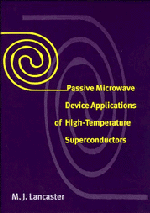Book contents
- Frontmatter
- Contents
- Preface
- Acknowledgements
- 1 Superconductivity at microwave frequencies
- 2 Superconducting transmission lines
- 3 Superconducting cavity resonators
- 4 Microwave measurements
- 5 Superconducting filters
- 6 Superconducting delay lines
- 7 Superconducting antennas
- 8 Signal processing systems
- Appendix 1 The surface impedance of HTS materials
- Appendix 2 Substrates for superconductors
- Appendix 3 Some useful relations
- Index
1 - Superconductivity at microwave frequencies
Published online by Cambridge University Press: 14 September 2009
- Frontmatter
- Contents
- Preface
- Acknowledgements
- 1 Superconductivity at microwave frequencies
- 2 Superconducting transmission lines
- 3 Superconducting cavity resonators
- 4 Microwave measurements
- 5 Superconducting filters
- 6 Superconducting delay lines
- 7 Superconducting antennas
- 8 Signal processing systems
- Appendix 1 The surface impedance of HTS materials
- Appendix 2 Substrates for superconductors
- Appendix 3 Some useful relations
- Index
Summary
Introduction
This first chapter deals with some fundamental aspects of how superconductors interact with high-frequency fields, and discusses the theoretical tools available for the solution of problems. Although superconductors were discovered in 1911 by H. Kamerlingh Onnes, it was not until the early 1930s that significant consideration was given to high-frequency effects. The thermal properties of superconductors were investigated by Gorter and Casimir in 1934, and they predicted a temperature dependence of superconducting carriers by minimising the Helmholtz free energy. To do this the carriers within a superconductor were assumed to consist of both superconducting and normal carriers whose relative densities changed as a function of temperature. This two-fluid model was taken further by the London brothers in 1934 to account for the high-frequency properties of superconductors. Their contribution is outlined in Section 1.2. The London equations can be used in conjunction with Maxwell's equations in order to allow them to be applicable to superconductors. Complex conductivity also follows from the two-fluid model. This simplifies the problem in that the normal conductivity σ can be replaced by a complex conductivity σ1 – jσ2, which accounts for superconducting phenomena. Heinz London also produced some early measurements on the surface resistance of tin, during which he discovered the anomalous skin effect, and Fritz London was the first to suggest that flux in a superconductor is quantised.
- Type
- Chapter
- Information
- Publisher: Cambridge University PressPrint publication year: 1997



